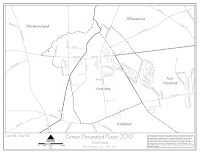Statistics have been split into urban and rural categories in decennial census publications for over a century. The definition of "urban" has changed over time in response to changes in settlement patterns, data use needs, and technology available for use in defining urban areas. The Census Bureau has continued to define "rural" as all territory, persons, and housing units not defined as urban. In the censuses of 1880, 1890, and 1900, places were deemed urban based on minimum population sizes of 8,000, 4,000, and 2,500 inhabitants respectively.
Beginning in 1910, the minimum population threshold to be categorized as an urban place was set at 2,500. "Urban" was defined as including all territory, persons, and housing units within an incorporated area that met the population threshold. The 1920 census marked the first time in which over 50 percent of the U.S. population was defined as urban.
The Census Bureau revised the urban definition for the 1950 census by adopting the urbanized area concept, to better account for increased growth in suburban areas outside incorporated places of 50,000 or more population. This change made it possible to define densely-populated but unincorporated territory as urban. The Census Bureau continued to identify as urban those places that had populations of 2,500 or more and were located outside urbanized areas. The Census Bureau also officially identified unincorporated places (referred to as census designated places (CDPs) starting with the 1980 census) located outside urbanized areas for the first time in 1950, and designated as urban any that contained at least 2,500 people within its boundaries. In 1960, the Census Bureau also adopted a population density threshold of at least 1,000 people per square mile for urbanized areas.
In the Census 2000, the Census Bureau adopted the urban cluster concept, for the first time defining relatively small, densely settled clusters of population using the same approach as was used to define larger urbanized areas of 50,000 or more population, and no longer identified urban places located outside urbanized areas. In addition, all urbanized areas and urban clusters were delineated solely on population density, without reference to place boundaries (for the 1950 through 1990 censuses, places were included in, or excluded from, urbanized areas in their entirety; exceptions were made for incorporated places containing substantial amounts of sparsely populated territory).
For the 2010 Census, the Census Bureau will be relying largely on what was established in the 2000 Census. An urban area will comprise a densely settled core of census tracts and/or census blocks that meet minimum population density requirements, along with contiguous territory containing nonresidential urban land uses as well as territory with low population density included to link outlying densely settled territory with the densely settled core. To qualify as an urban area on its own, the territory identified according to the criteria must encompass at least 2,500 people, at least 1,500 of which reside outside institutional group quarters. Urban areas that contain 50,000 or more people are designated as urbanized areas (UAs); urban areas that contain at least 2,500 and less than 50,000 people are designated as urban clusters (UCs). The term "urban area" refers to both UAs and UCs. The term "rural" encompasses all population, housing, and territory not included within an urban area.





































